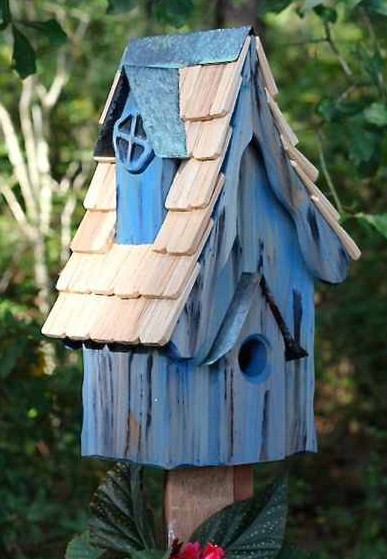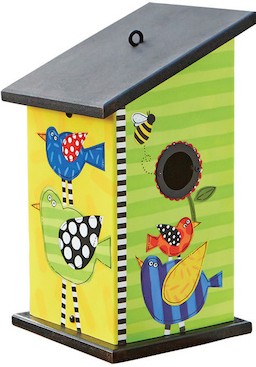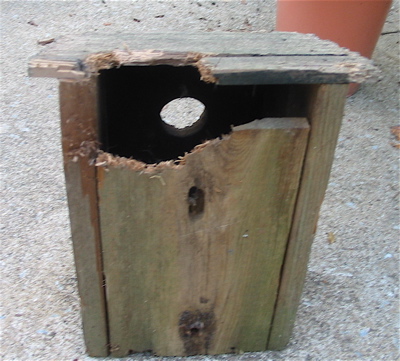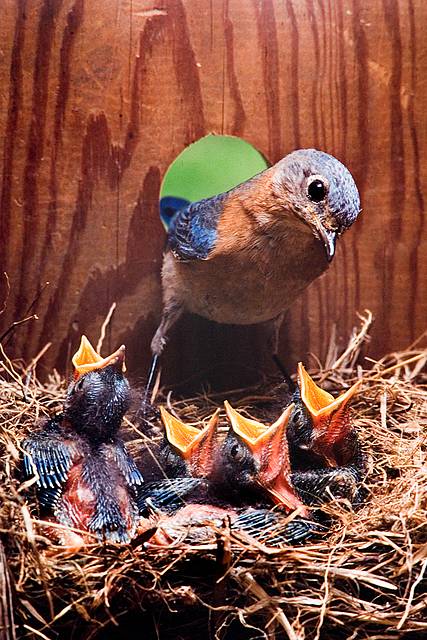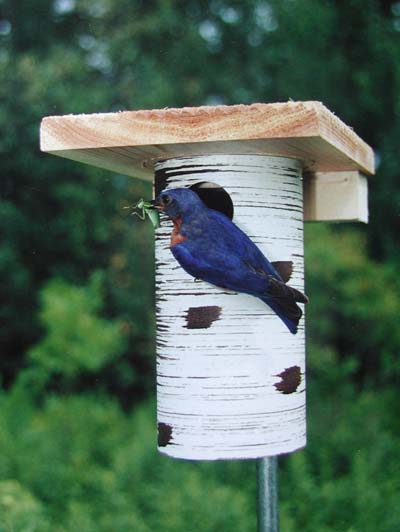-
Don’t Let Sparrows Nest in Blue Bird Houses
Not all blue bird houses are created equal!
Depending on how much you’re willing to commit may play a part in choosing a house to host bluebirds. If you’re more of the “set it & forget it” kind (and that’s okay) at least use a quality wood or vinyl birdhouse. These usually have proper drainage, decent ventilation, adequate floor space and proportional entries (1.5 inches for Eastern blues and 1-9/16 inch for mountain and Western species).
Metal decorative houses really aren’t the best choice, especially since bluebirds (and some other species) tend to have 2-3 clutches or broods per season. During hot summer days… metal heats up and babies can fry 🙁
Predator guards are always helpful, both on the entry to keep grabby paws and larger bully birds out, and on the pole itself – in the form of a baffle. If the birdhouse hangs, simply use a hanging squirrel baffle above for further protection from predators.
The National Bluebird Society approves housing that is monitor-friendly, meaning you can easily access inside to see how the nest is progressing and babies are faring. Most bluebird specific houses have side doors for viewing, Gilbertson houses pop on & off of the roof via two pins, and the popular Peterson style has a front door that pulls down for nest checks. Seasoned bluebird monitors all have their favorites for different reasons!
But why would anyone want to see how the nest is progressing? House sparrows… they mustn’t be allowed to nest if you’re trying to attract bluebirds. They’re enemies, brutal enemies of native bluebirds. Until one witnesses the carnage- it’s difficult to grasp, and although native- house wrens should be deterred as well. The other day I was screaming at starlings in the yard when my friend insisted “they’re birds too-they deserve to eat.” Not here, nope, no can do! Also non-native, and invasive, they compete for nesting space with brutal tactics, not to mention the mess on every baffle and feeder around the yard!
If you’re new to hosting bluebirds, nature will show both the pleasures and heartache she can bear. Knowing a few basics will have you on your way in no time! Watch for sparrow nests, usually piled high and messy, with bits of trash woven throughout. They tend to have a tunnel-type entrance as well. House wrens will lay claim by placing sticks inside, criss-crossed, piled up twigs. They’ll do this even when not using the birdhouse to nest… but simply to keep others out of their territory. The website Sialis.org has a wealth of knowledge on identifying nests, eggs, behaviors and everything pertinent to bluebirds and other native cavity dwelling birds. Definitely worth a look!
-
Friend and Foe Use Bluebird Houses Through Winter
Fairly late and third nesting reports for Eastern bluebirds were common this year, possibly due in part to the previously treacherous winter and their delayed instincts for claiming territories and nest boxes (nest starts).
Now’s a great time to check bluebird houses for repairs and remove nesting materials from the busy spring season. Although bluebirds don’t usually roost in houses… others will! Offering shelter through tough winter months for resident birds is simple if you have a house or two up already. Just clean them out and check for repairs. And a good cleaning is optimal if you have the time, a diluted bleach solution works great. Use a 1:10 ratio of bleach to water and a good scrub brush. Rinse well, let air dry and replace.
Squirrels can do a number on wood birdhouses, especially enlarging the entries to gain access. If the damage isn’t too bad yet, it’s an easy fix by adding a metal or brass portal over the entrance. It’s a good way to save your birdhouses for the birds and deter squirrels through winter. Well… some squirrels anyway!
For the past few years we’ve had a downy woodpecker who claims a bluebird house for nightly roosting, it’s actually pretty cool! House sparrows on the other hand, should be discouraged from roosting in any houses… they’re a major foe of the bluebird and most native cavity nesting birds.
If and when you do go to clean out houses, you may see droppings which will give you a clue as to who’s roosting in there. If they’re white, you can bet house sparrows are in the area. Black droppings with seeds indicates bluebirds. Let’s hope for the latter 🙂
-
Happy Father’s Day from Inside the Blue Bird Houses!
Many males in the winged world also labor in raising their families, so today we salute all of the hard working dads who help raise their kids!
A typical view inside blue bird houses, dad keeps a watchful eye on nestlings, while taking turns with mom bringing food to the babies.
The digs: A male bird’s skill at nest building is a sign of his suitability as a mate; he invests huge effort in the task. Males will build multiple nests to attract females, they’ll continue to build new nests until a female is happy with the construction and chooses one.
The food: Many male birds help raise their families, bringing food home to the babies. Sometimes they even have to incubate the eggs alone or take turns with the female. Male bald eagles, for example, take turns sitting on the eggs as well as bring food home to the young.
Protection: In species where both parents care for the young, the male often gathers food while the female spends more time brooding, keeping the baby birds warm, sheltered and safe from predators.
– Western Bluebirds usually breed in monogamous pairs. By the end of breeding season, most daughters disperse; most sons and the occasional daughter remain with their family for winter. In spring, the yearlings go off and nest on their own, but sometimes one or more sons stay to help their parents. Sometimes a bluebird with his own mate will help at his parents’ nest, while also feeding his own young next door. Source citation: The Cornell Lab of Ornithology
Happy Father’s Day to All~We salute your dedication to family!

